Uncovering the Best Innoslate Alternatives for Systems Engineering
Innoslate stands out as a comprehensive solution for the entire systems engineering lifecycle, extending beyond just requirements management. Its impressive capabilities include quick import analysis, quality checks, automatic diagram creation, risk reduction through simulators, functional and physical modeling, and a built-in test center for verification. While Innoslate offers robust features like real-time collaboration and flexible deployment options (on-premise or SaaS), organizations often seek Innoslate alternatives that might better suit specific project needs, budget constraints, or existing technology stacks. This article explores several top contenders that offer similar, or even complementary, functionalities to Innoslate.
Top Innoslate Alternatives
Whether you're looking for a more specialized tool, a different pricing model, or a platform that integrates seamlessly with your current ecosystem, these alternatives provide compelling options for various systems engineering and requirements management demands.

Traceable Requirement Management
Traceable Requirement Management is a commercial Windows-based platform that excels at improving the global requirement management process. It allows organizations to effectively capture, delegate, track, and verify requirements, ensuring the final design aligns with initial specifications. Its focus on end-to-end traceability makes it a strong Innoslate alternative for those prioritizing granular control over their requirements workflow.

ReqView
ReqView offers a simple yet powerful approach to requirements management. Available as a freemium model with commercial options, it supports Mac, Windows, Linux, and Web platforms. ReqView is an excellent Innoslate alternative for capturing structured requirements for software or system products and provides robust tracking capabilities, making it ideal for teams seeking a focused and user-friendly requirements solution.

Cradle
Cradle by 3SL is a comprehensive multi-user requirements management and software/systems engineering tool, perfect for both agile and phased-based projects. As a commercial solution available on Windows, Linux, and as a SaaS, Cradle provides extensive features including Model Based Systems Engineering, Configuration Management, UML entity creation, document scanning and management, linking models to requirements, and robust test case management. Its broad feature set makes it a formidable Innoslate alternative for complex engineering projects.

Jama Software
Jama Software is a leader in product development software, offering commercial SaaS solutions that prioritize requirements management, traceability, and test management with exceptional ease of use. It provides real-time collaboration and workflow management features, making it a compelling Innoslate alternative for teams that value seamless communication and streamlined development processes.

PTC Integrity
PTC Integrity is a commercial self-hosted solution available for Windows and Linux that enables users to create and manage data across the entire SDLC. It serves as a central repository for software, requirements, tests, and traces, ensuring comprehensive control and visibility. PTC Integrity's ability to act as a central hub for all development artifacts makes it a strong Innoslate alternative for organizations requiring a robust, integrated data management system.
Choosing the right systems engineering or requirements management tool is crucial for project success. While Innoslate offers a powerful all-in-one solution, exploring these Innoslate alternatives can help you find a platform that precisely fits your team's unique needs, whether that's specialized features, specific platform compatibility, or a different pricing structure. Carefully evaluate each option based on your project scope, team size, and budget to select the best fit.